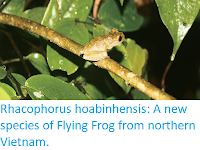Molecular studies have suggested that the earliest crown-group Frogs, Anurans, are likely to have lived in the Late Triassic (in evolutionary biology the 'crown group' includes everything descended from the last common ancestor of all the living members of the group, while the 'stem group' includes everything more closely related to the crown group than to the nearest living relatives of that group, in this case the Newts and Salamanders, Urodels). However the early fossil record of Frogs is poor, with only two fossil Salientians (the group which includes crown and stem group Frogs) known from the Triassic, Triadobatrachus massinoti, from the Early Triassic of Madagascar, and Czatkobatrachus polonicus from the Early Triassic of Poland, and one from the Early Jurassic Prosalirus bitis from Arizona. Interestingly, like many small Tetrapod fossils from the Triassic, both Triadobatrachus massinoti and Czatkobatrachus polonicus come from regions interpreted as having had temperate climates, in the Southern and Northern hemispheres respectively, while crown group Frogs are thought most likely to have originated in the tropics.
In a paper published in the journal Biology Letters on 27 February 2019, Michelle Stocker and Sterling Nesbitt of the Department of Geosciences at Virginia Tech, Ben Kligman, also of the Department of Geosciences at Virginia Tech, and of the Petrified Forest National Park, Daniel Paluh of the Florida Museum of Natural History at the University of Florida, Adam Marsh, also of the Petrified Forest National Park, David Blackburn, also of the Florida Museum of Natural History at the University of Florida, and William Parker, again of the Petrified Forest National Park, describe a series of partial Salientian specimens from the Late Triassic Chinle Formation of Arizona.
The Chinle Formation outcrops across a wide area of Nevada, Utah, Arizona, New Mexico, and Colorado, and comprises a series of terrestrial and freshwater deposits laid down close to the equator, including several braided-river sequences, lake systems, and the Petrified Forests of Arizona and New Mexico, these apparently comprising the outer parts of a river basin with occasional flood events.
The first specimen described, DMNH 2018-05-0002, is a nearly complete right ilium (the largest part of the hip-bone complex) from the collection of the Perot Museum of Nature and Science, found within a green conglomeratic lens within the lower part of the Jim Camp Wash beds of the Sonsela Sandstone Member, a braided river sequence within the Chinle Formation, to the south of the Petrified Forest National Park, dated to between 217.7 and 213.87 million years ago. This has a elongate and distally hollow iliac shaft, something found in all Anurans and some non-Anuran Salientians, but not in any other group.
Stocker et al. also describe three partial left ilia and a partial maxila from a carbonate nodule-rich mudstone layer within the lower-middle portion of the Sonsela Member near St. Johns, Arizona, dated to about 219.39 million years old, and a coprolitic horizon near Billing’s Gap in the Petrified Forest National Park, dated to between 223.036 and 220.123 million years old.
See also...
The first specimen described, DMNH 2018-05-0002, is a nearly complete right ilium (the largest part of the hip-bone complex) from the collection of the Perot Museum of Nature and Science, found within a green conglomeratic lens within the lower part of the Jim Camp Wash beds of the Sonsela Sandstone Member, a braided river sequence within the Chinle Formation, to the south of the Petrified Forest National Park, dated to between 217.7 and 213.87 million years ago. This has a elongate and distally hollow iliac shaft, something found in all Anurans and some non-Anuran Salientians, but not in any other group.
Comparisons of the primary Late Triassic specimen from the Chinle Formation (DMNH-2018-05-2002) to the ilia of stem anurans, including Triadobatrachus (MNHN-F-MAE126), Czatkobatrachus (ZPAL Ab IV/114), Prosalirus (MCZ-VP-9324A) and extant Anurans from the earliest diverging crown lineages, including Ascaphus truei (UF-Herp-80664), Leiopelma hamiltoni (CAS-Herp-53931), Alytes obstetricans (CAS-SU-21691) and Barbourula busguangensis (KU 309278). All figured in right lateral view with anterior to the right. Abbreviations: ace: acetabulum. Scale bar equals 1.0 mm. Stocker et al. (2019).
Stocker et al. also describe three partial left ilia and a partial maxila from a carbonate nodule-rich mudstone layer within the lower-middle portion of the Sonsela Member near St. Johns, Arizona, dated to about 219.39 million years old, and a coprolitic horizon near Billing’s Gap in the Petrified Forest National Park, dated to between 223.036 and 220.123 million years old.
See also...
Follow Sciency Thoughts on Facebook.







